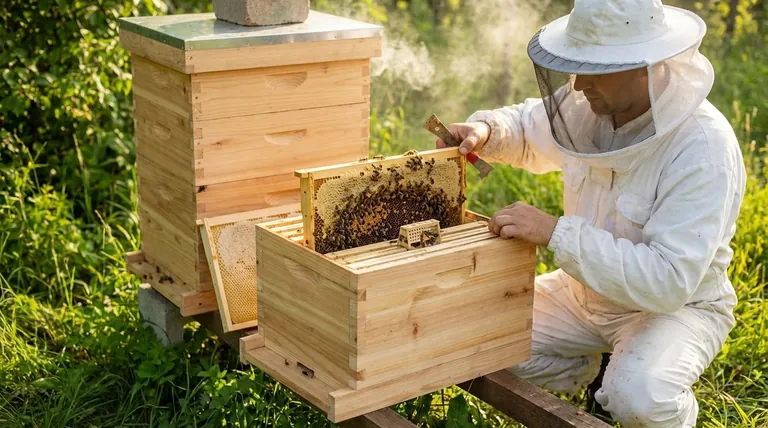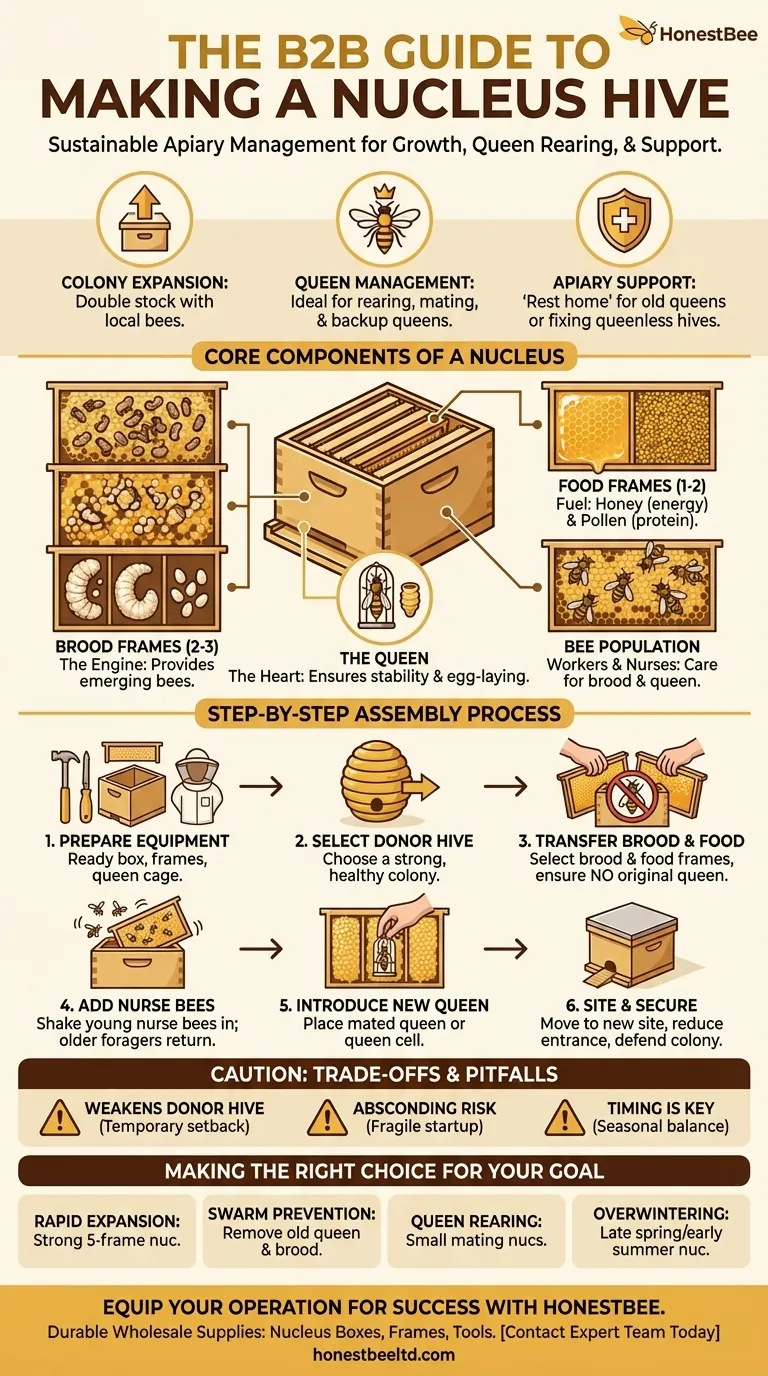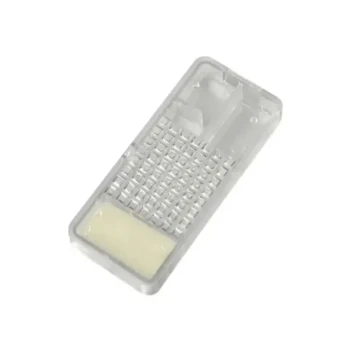In beekeeping, creating a nucleus hive, or "nuc," is the process of taking a small population of bees along with frames of brood and food from a strong, established colony. This new, smaller colony is then housed in a special nucleus box and given a new queen or a queen cell, allowing it to develop into a full-sized hive. This technique is a cornerstone of sustainable apiary management.
A nucleus is more than just a small hive; it is the fundamental building block for managing colony health, executing swarm control, and propagating desirable genetics throughout your apiary.

Why Create a Nucleus Hive? The Strategic Advantages
Understanding the purpose behind making a nucleus is critical, as it dictates the composition and timing of its creation. It is a versatile tool for proactive apiary management.
For Colony Growth and Expansion
The most common reason to make a nucleus is to increase your number of colonies. By splitting a strong hive, you can essentially double your stock using your own local, adapted bees rather than purchasing packages or nucs from outside sources.
For Queen Management and Rearing
Nucleus hives are the ideal environment for raising and mating new queens. Their small population makes it easier for a new virgin queen to take her mating flights and begin laying without the pressures of a massive colony. They are also used to house a spare, proven queen as a backup in case a production hive's queen fails.
As an Apiary Support System
A nucleus can serve as a "rest home" for an older but genetically valuable queen, allowing her to continue laying at a slower pace. It can also be used to quickly resolve a queenless colony by uniting the nuc with the larger population.
The Core Components of a Successful Nucleus
A viable nucleus is a balanced, miniature version of a full hive. Each component is essential for its survival and growth.
The Brood Frames: The Engine of the Colony
You need frames containing eggs, larvae, and capped brood. Capped brood provides the emerging bees that will rapidly increase the nuc’s population, while eggs and young larvae ensure a continuous cycle of new bees. A typical five-frame nuc includes two to three frames of brood.
The Food Frames: Fuel for Growth
Honey and pollen are critical. One to two frames of capped honey provide the necessary carbohydrates for energy, while a frame with stored pollen (bee bread) provides the protein required to feed the developing larvae.
The Bee Population: Workers and Nurses
When you transfer the brood frames, you must ensure they are covered with nurse bees. These are the younger bees responsible for caring for the queen and the brood. Shaking additional bees from other brood frames into the nuc ensures a robust initial population.
The Queen: The Heart of the Hive
A nucleus needs a queen. You can either introduce a mated queen you have purchased or raised, or you can add a queen cell that is a day or two from emerging. If the donor hive has swarm cells, this is a perfect resource for your new nuc.
The Step-by-Step Assembly Process
This process should be performed on a warm, calm day to minimize stress on the bees.
Step 1: Prepare Your Equipment
Have your nucleus box, frames, and any protective gear ready. If you are introducing a new queen, have her in a queen cage prepared for introduction.
Step 2: Select the Donor Hive
Choose one of your strongest, healthiest, and most productive colonies. A powerful hive can easily spare a few frames of brood and bees without significantly impacting its own progress.
Step 3: Transfer Brood and Food Frames
Find the queen in the donor hive and isolate the frame she is on to ensure you do not accidentally transfer her. Select two frames of capped and emerging brood and one frame of honey and pollen. Place these frames in the center of the nucleus box.
Step 4: Add the Bees (Without the Original Queen)
Take one or two additional frames of open brood covered in nurse bees from the donor hive. Shake these bees directly into the nucleus box and return the frames to the donor hive. The older forager bees will fly back to their original hive, leaving the young nurse bees behind.
Step 5: Introduce the New Queen or Queen Cell
Place your new mated queen (in her cage) between two of the brood frames. If using a queen cell, gently press it into the wax of a central brood frame. If you've ensured no queen or young larvae came from the donor hive, the bees will accept the cell.
Step 6: Site and Secure the New Nucleus
Close the nucleus box and place an entrance reducer on the smallest opening to help the small colony defend itself. Move the nuc to a new location in the apiary, ideally several feet away from the parent hive, to minimize drifting.
Understanding the Trade-offs and Common Pitfalls
While powerful, making a nucleus is not without risks that require careful management.
Weakening the Donor Colony
Removing brood, bees, and food resources will temporarily set back the donor colony. This must be done judiciously, especially before a major honey flow, as it can reduce the hive's foraging workforce and subsequent honey surplus.
Risk of Absconding or Failure
A new nucleus is fragile. If the population is too small, there isn't enough food, or the weather turns poor, the bees may fail to raise the brood or may abscond entirely. Ensuring a proper balance of resources is non-negotiable.
The Importance of Timing
Making a nuc too late in the season may not give it enough time to build up the necessary population and food stores to survive winter. Conversely, making one too early with insufficient resources can lead to its failure during unpredictable spring weather.
Making the Right Choice for Your Goal
The composition of your nucleus should directly reflect your primary objective.
- If your primary focus is rapid expansion: Make strong five-frame nucs with at least three frames of brood and plenty of bees to ensure fast growth into a full-sized colony.
- If your primary focus is swarm prevention: Create a nuc by removing brood and the old queen from a congested hive, leaving them to raise a new queen from a swarm cell, which satisfies their swarming impulse.
- If your primary focus is raising new queens: Use smaller, three-frame "mating nucs" with just enough bees and food to support the queen through her mating and early laying period.
- If your primary focus is overwintering spare colonies: Create your nuc in late spring or early summer to give it the entire season to build into a powerful, well-fed colony ready for winter.
Mastering the creation of nucleus hives transforms you from a reactive to a proactive beekeeper, giving you ultimate control over your apiary's destiny.
Summary Table:
| Component | Purpose | Typical Quantity |
|---|---|---|
| Brood Frames | Provides emerging bees and future population growth | 2-3 frames (eggs, larvae, capped brood) |
| Food Frames | Supplies carbohydrates and protein for energy and larval development | 1-2 frames (honey & pollen) |
| Bee Population | Young nurse bees to care for the queen and brood | Covered frames + shaken bees |
| The Queen | The heart of the new colony; ensures egg-laying and stability | 1 mated queen or queen cell |
Ready to build a stronger, more resilient apiary?
Mastering the creation of nucleus hives is key to proactive beekeeping. To succeed, you need reliable, high-quality equipment. HONESTBEE supplies commercial apiaries and beekeeping equipment distributors with the durable nucleus boxes, frames, and tools essential for this process. Our wholesale-focused operations ensure you get the professional-grade supplies you need to efficiently manage colony health, control swarms, and propagate desirable genetics.
Let's equip your operation for success. Contact our expert team today to discuss your wholesale beekeeping supply needs!
Visual Guide

Related Products
- 5 Frame Wooden Nuc Box for Beekeeping
- Twin Queen Styrofoam Honey Bee Nucs Mating and Breeding Box
- Automatic Heat Preservation 6 Frame Pro Nuc Box for Honey Bee Queen Mating
- Plastic Transporting Bee Packages and Nuc Boxes for Beekeeping
- Styrofoam Mini Mating Nuc Box with Frames Feeder Styrofoam Bee Hives 3 Frame Nuc Box
People Also Ask
- What is a common feature of many 5-frame nuc boxes? The Integrated Feeder for Efficient Colony Growth
- What is the advantage of overwintering a nucleus? A Strategic Asset for Beekeeping Success
- How many frames does a typical wooden nuc box hold? A Guide to Choosing the Right Size
- What is the purpose of having a nuc in beekeeping? Build a Resilient & Productive Apiary
- How should the nuc be installed in the apiary? Ensure Colony Success from Day One



















